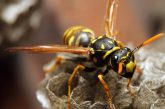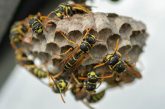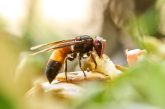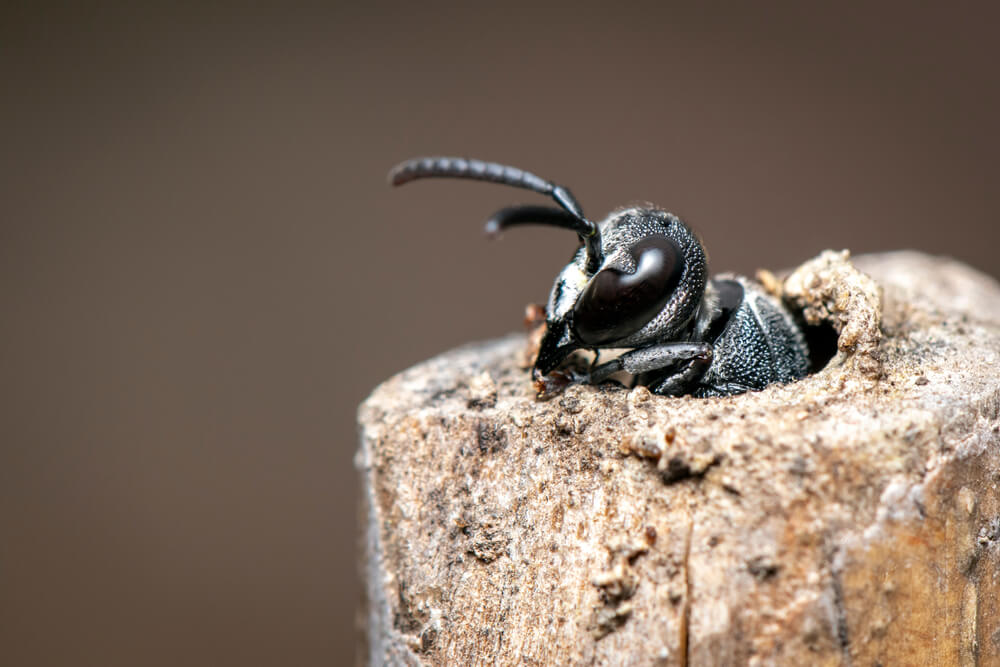
The Great Black Wasp, known for its imposing size and striking appearance, is a fascinating creature often found in North America. Identifying this solitary wasp involves noting several distinctive features. True to its name, the Great Black Wasp boasts a glossy black body that can measure up to an impressive 1.5 inches in length. Its wings, also dark and iridescent, contribute to its formidable presence.
Key characteristics of the black wasp include its elongated body and narrow waist, typical of many wasp species. Unlike social wasps such as yellowjackets or hornets, the Great Black Wasp is solitary by nature. This means that each female constructs her own nest rather than working within a colony.
Understanding where these wasps live provides insight into their nesting habits and ecological role. The Great Black Wasp prefers open fields and meadows where it can find soft soil to dig burrows for nesting. These burrows are typically located in sunny areas with loose soil that’s easy to excavate.
By familiarizing ourselves with these identification markers and habitat preferences, we gain a greater appreciation for the unique lifestyle of this solitary insect, a reminder of the diverse roles different species play in our ecosystem.
The Role of Great Black Wasps in the Ecosystem
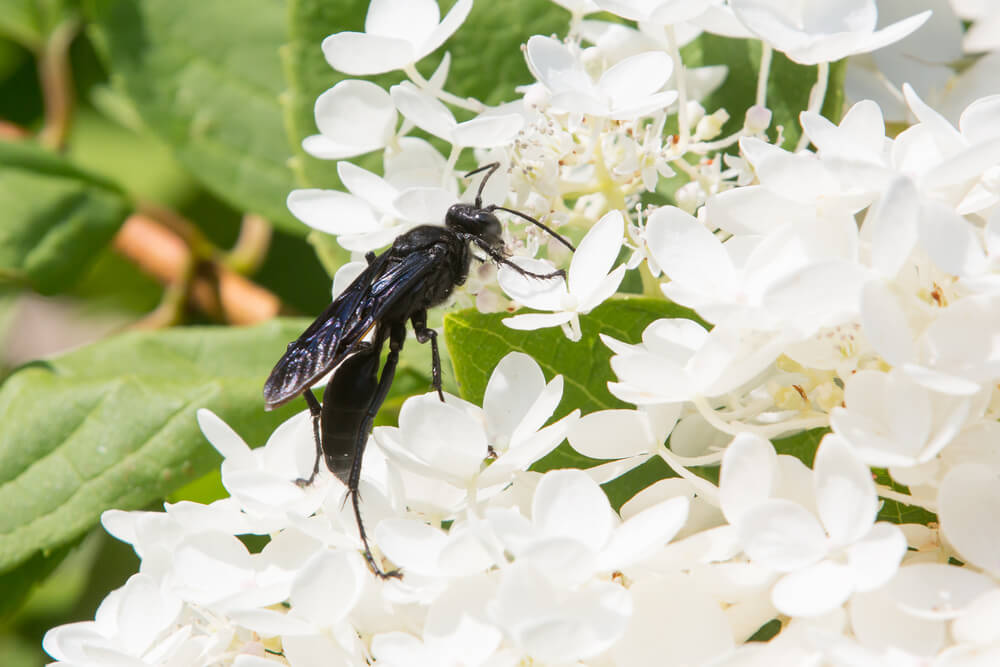
The Great Black Wasp plays a vital role in maintaining the health and balance of ecosystems. One of the primary benefits of great black wasps is their contribution to natural pest control. These wasps are predators, primarily feeding on harmful insects such as grasshoppers, katydids, and crickets. By keeping the population of these pests in check, great black wasps help protect plants and crops from potential damage.
In addition to their role as natural pest controllers, great black wasps also contribute to pollination. While they are not as renowned as bees for this task, pollination by wasps occurs when they visit flowers for nectar. As they move from flower to flower, they inadvertently transfer pollen, aiding in the reproduction of various plant species.
The presence of great black wasps is essential for ecosystem balance. By controlling pest populations and assisting in pollination processes, these insects support biodiversity and ensure that both flora and fauna thrive harmoniously within their habitats. Understanding and appreciating the ecological roles played by such creatures can inspire efforts toward conservation and sustainable practices that benefit all living organisms.
Potential Risks Posed by Great Black Wasps and When to Consider Removal
Great black wasps, known for their striking appearance and solitary nature, are generally considered beneficial insects due to their role in pollination and controlling pest populations. However, understanding the potential risks they pose is essential for ensuring safety around them. One of the primary concerns is the danger of great black wasp stings. Although these wasps are not typically aggressive, they can sting if provoked or threatened.
For most people, a sting from a great black wasp results in mild discomfort or localized pain. However, individuals who have an allergic reaction to wasp stings may experience more severe symptoms such as swelling, difficulty breathing, or even anaphylaxis. This life-threatening condition requires immediate medical attention.
It’s important to be aware of when black wasps might become aggressive. These insects are generally docile but may display defensive behavior if their nests are disturbed or if they feel cornered. If you notice a significant number of great black wasps near your home or garden and they’re causing concern due to their proximity to living spaces or frequent human activity areas, it might be time to consider removal.
Consulting with a professional pest control service can help determine the best course of action while minimizing harm to both humans and the beneficial insect population. By taking appropriate precautions and understanding both the benefits and risks associated with great black wasps, you can safely coexist with these fascinating creatures while protecting your health and well-being.
Effective Methods for Safely Getting Rid of Great Black Wasps
Dealing with a great black wasp infestation can be a daunting task, but understanding effective methods for safely removing these insects is crucial. When considering how to remove a wasp nest safely, it’s important to prioritize both personal safety and environmental impact.
One of the most effective approaches is utilizing non-toxic pest control methods. These solutions often involve natural ingredients that deter wasps without causing harm to beneficial insects or the surrounding ecosystem. For instance, peppermint oil and vinegar sprays are popular DIY pest control solutions that can be applied directly to nests or areas where wasps are frequently seen.
However, if the infestation is extensive or if you’re uncomfortable handling it on your own, professional pest removal services offer a reliable alternative. These experts have the experience and tools necessary to manage wasp nests efficiently and safely, ensuring that your home remains secure from potential stings or structural damage.
For those inclined towards DIY pest control for insects, wearing protective clothing and working during cooler parts of the day when wasps are less active can enhance safety. Always ensure you have an escape route planned in case of an unexpected swarm.
By assessing the situation carefully and choosing between natural remedies or professional help, you can effectively manage great black wasps while maintaining peace of mind.
How to Minimize Wasp Presence in Your Yard
Wasps can be a nuisance in any garden, but with the right strategies, you can minimize their presence and enjoy your outdoor space without worry. Preventing wasps from nesting begins with effective garden maintenance. Regularly inspect your yard for potential nesting sites, such as overhangs, eaves, and crevices. Sealing these areas can deter wasps from settling in.
Garden maintenance tips for pest prevention include keeping your yard tidy by trimming hedges and mowing the lawn frequently. Wasps are attracted to food sources, so ensure that garbage bins are tightly sealed and avoid leaving food scraps outside.
Incorporating natural repellents for insects is another effective strategy. Planting herbs like mint, eucalyptus, or citronella around your garden can naturally deter wasps due to their strong scents. Additionally, creating homemade sprays using essential oils such as peppermint or clove oil mixed with water can serve as a natural deterrent when applied around common entry points.
By combining these preventive measures, you can significantly reduce the likelihood of wasp infestations in your garden while maintaining an environmentally friendly approach to pest control.
Balancing Coexistence with Control in Managing Great Black Wasps
In the delicate ecosystem of our gardens and landscapes, great black wasps play an essential role as pollinators and natural pest controllers. However, their presence can sometimes be overwhelming or intimidating. Striking a balance between coexistence and control is crucial for maintaining harmony in these environments.
Understanding the behavior and benefits of great black wasps is the first step towards peaceful coexistence. These solitary insects are generally non-aggressive unless provoked, making them less of a threat than other stinging species. By recognizing their contribution to pollination and pest management, we can appreciate their role in biodiversity.
When control becomes necessary due to high populations or personal discomfort, it’s important to employ humane and environmentally friendly methods. This might include encouraging natural predators or carefully relocating nests rather than resorting to chemical solutions that could harm beneficial insects.
In conclusion, managing great black wasps requires a thoughtful approach that respects both ecological balance and human comfort. By fostering understanding and employing gentle control measures when needed, we can ensure these valuable insects continue to thrive alongside us without conflict.

